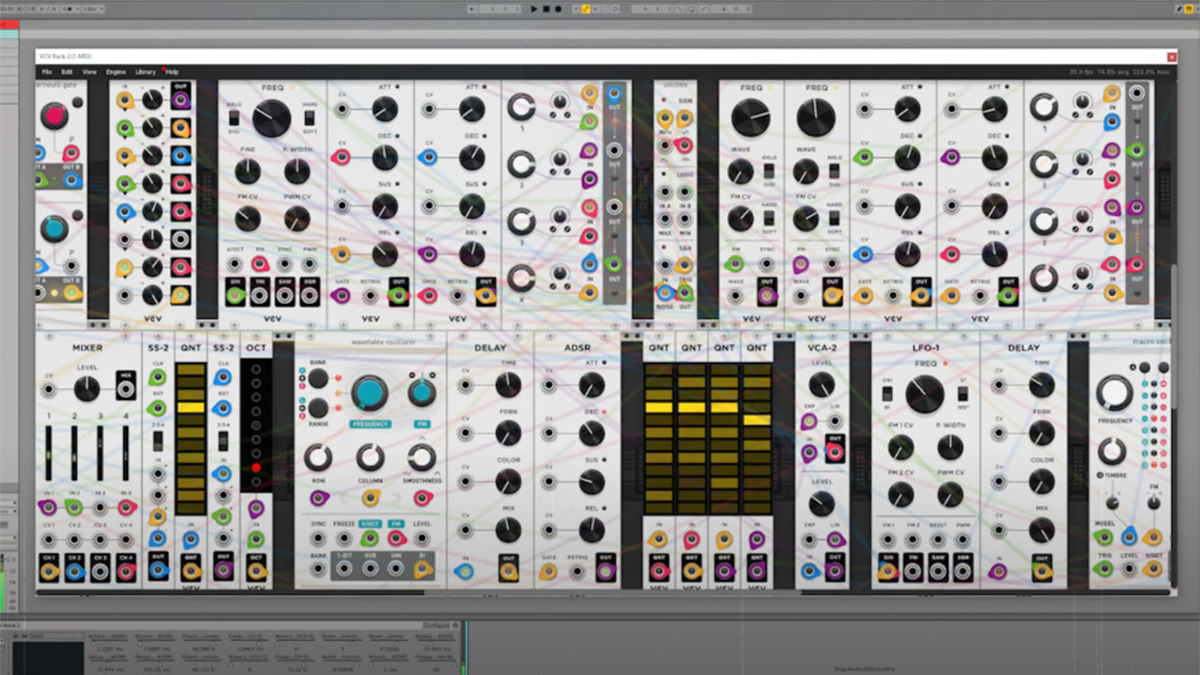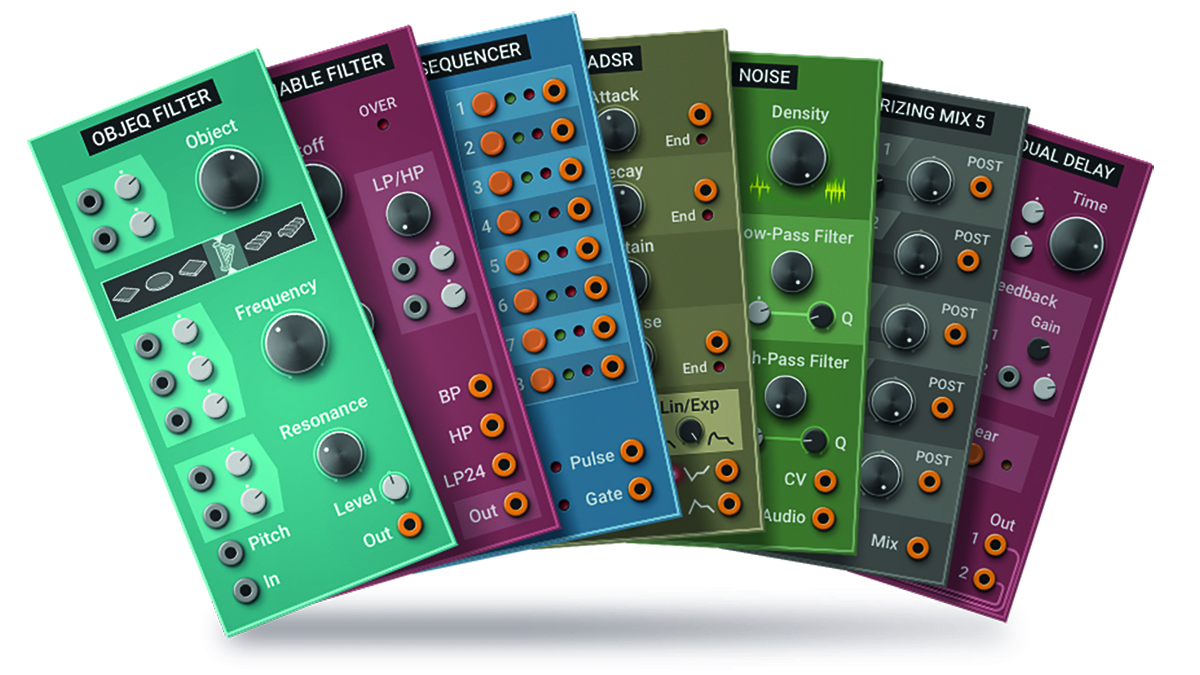MusicRadar Verdict
If you fancy dipping your toe in the modular domain, this is an excellent, cost effective way to start, and sounds superb.
Pros
- +
Highly versatile architecture.
- +
Worthy synth engine for simple patches.
- +
Engaging for more complex patching.
- +
Presets are useful for inspiration.
Cons
- -
More VCOs and filters would have been welcome.
- -
Onboard tips for new users would help.
MusicRadar's got your back
Applied Acoustics Systems Multiphonics CV-1: What is it?
Price: $99/£79/€95
Mac: macOS 10.11 (El Capitan or later). Intel Core i5 (circa 2015), Apple M1 processor or later. 64-bit DAW
Windows: 10 64-bit or later. Intel Core i5 (circa 2015) processor or later. 64-bit DAW
Buy: Plugin Boutique
While there is nothing new about modular synthesis, the undeniable rise of the Eurorack format in more recent years has influenced a number of companies to investigate the concept by creating a modular in software. This desktop-based format has found bedfellows from both the desktop diehards, as well as the modular enthusiasts themselves, partly thanks to the enticing cost, alongside the ability to save patches and implement directly with your DAW.
Canadian developer Applied Acoustics Systems is no stranger to the software domain. It is the developer behind an ever-growing catalogue of superbly usable instruments such as the applauded Chromaphone 3 synthesiser and the excellent Lounge Lizard EP-4 electric piano simulator.
Multiphonics CV-1 veers into new territory for AAS, providing a modular synthesiser environment, which can be used in either a standalone form or as a plugin within your DAW. As any modular synth user who is more accustomed to hardware will tell you, there is something quite enticing about an instrument that you can use without the need to load your DAW. But before we begin to understand why this is such a deep rooted desire, let’s dive in with the basics.
There’s something enticing about an instrument you can use without the need to load your DAW
Presets and modules
Multiphonics CV-1 offers a fully fledged modular experience, which begins with a virtual rack case, in which you are able to load modules. At the current count, there are 37 modules available. Some of these will be intrinsic to sound creation, while others will shape the sound, trigger tones, or offer utility-style operation, all within the confines of a modular system. These utilitarian modules are invaluable, even though they may only be doing something as basic as summing signals.

• VCV Rack 2
Now in its version 2 form, available as a free package or paid Pro version, for high-end setups.
• Softube Modular
Offers licensed software facsimiles of some of Eurorack’s greatest hits!
The concept of patch creation is identical to that found in the hardware modular domain. For a basic subtractive synthesis patch, you will need the usual common denominators of an oscillator, filter, envelope and amplifier. Loading modules into the virtual rack is a simple process of selecting the module menu and clicking on the module required. Modules can then be dragged around, in order to simplify the flow of your patch, while connections are made through virtual patch cables, by clicking on an input or output, and dragging the cable to the appropriate connection point. Unlike a hardware modular, you won’t be struggling to have the correct length of cable, as all cables will adjust to suit the connection you wish to make. Neither will you have an excess of cables, dangling in the way of the modules that you’ve been trying to work with!
If you’re new to the modular environment, visiting and viewing some of the walkthroughs which are available from the AAS website would be very much worthwhile, to get your head around the modular concept. There’s also a great selection of patches, which are organised into categories, such as basses, leads, percussion and generative patches.
Applied Acoustics Systems Multiphonics CV-1: Performance and verdict
If you want to keep things simple to begin with, there are four audio generator modules available, to form the starting point for a subtractive patch. Two of these are more conventional VCO-style modules, while a specific Pulse VCO and Noise module are also available.
To add to the oscillators, there are three different filter modules; the first is a regular ladder filter, which is equipped with four different slopes from 6dB to 24dB. The on-board addition of an overdrive allows the ladder filter to be overdriven. Meanwhile there is also a state variable filter module, which will happily move between high and low-pass states, with the addition of a band-pass option.
The third module is the most unique of the three; the Objeq Filter is a form of modelling filter, which is influenced by shapes such as drum heads, strings and membranes, and allows for a unique sweeping effect, as you move between filter forms. As we’re in the modular domain, this is open to modulation from a number of sources, and can create some very beautiful and inspiring tones, even from the most minimal of oscillator inputs.
It can create some very beautiful and inspiring tones, even from the most minimal of oscillator inputs
CV-1 also includes envelopes, LFOs and VCAs, among the basic module set. The envelope module is a 4-stage ADSR, with the VCA modules being available in solo or duo form, while accompanied by a Low Pass Gate.
In setting up the most basic of patches, you will still need to provide the envelope with a trigger input, and an accompanying envelope output, heading in the direction of your VCA. It is relatively self-explanatory for anyone who is used to the modular concept, but it could take a little manual diving, or reverse engineering of existing patches, for any newcomers to the modular world.
Generative patching
One of the alluring elements of CV-1 is that it’s a standalone, breathing, growing, organic instrument. While many modular users will use their hardware in a conventional way by creating subtractive synth patches (albeit complex in nature), it’s incredibly appealing to use a modular in a generative way.
This means that the modular itself may create the very notes being triggered, in an entirely randomised way. If this sounds a little haphazard, it can be, but it’s also very plausible to place constraints on the level of generation. By applying these constraints through elements such as quantising modules, the output can be less randomised, and more scalic or sequential. It is also possible to organise patches in such a way that a root note can act as the base for your sequence, meaning that it’s far easier to employ within your production and DAW, if so required. Generative patch creation is the modular equivalent of disappearing down the rabbit hole, and you can find yourself in a time vacuum, while creating a patch of this kind.
Thankfully, AAS provides a number of generative patches in a preset section. This is not only useful for inclusion in your own music, but also as a point of reverse engineering, in order to discover how patches have been created. As with all modular setups and software, you can go as deep into the process as you like!

Getting creative
Taking CV-1 beyond the basic steps is a rapid concept. The more modules that you add, the more that you will need to employ elements such as mixers, in order to sum signals and output them appropriately.
Thanks to the addition of on-board sequencers, these can easily be synchronised to the master clock module, at the top of the rack. This will, in turn, lock to your DAW, meaning that you can create sequences within the modular, for triggering within your overall production. Add an extensive number of signal processing modules, for processing both audio and CV, and it’s quite a package of creativity.
Sonically, CV-1 can sound beautiful and aggressive in equal quantity. The filters are lovely and wispy, while the Objeq filter is an incredibly inspiring tool. As with any complex sound creation instrument of this kind, it’s inspiring on a preset level, but continues to reward on a creative level, if you have the time to get your hands dirty and create patches from scratch. And it doesn’t get much more fulfilling than that!
MusicRadar verdict: If you fancy dipping your toe in the modular domain, this is an excellent, cost effective way to start, and sounds superb.
Applied Acoustics Systems Multiphonics CV-1: Hands-on demos
Applied Acoustics Systems
Nu-Trix The Synth Guy
Time+Space
Applied Acoustics Systems Multiphonics CV-1: Specifications
- macOS 10.11 (El Capitan) or later. Intel Core i5 (circa 2015), Apple M1 processor or later. 64-bit DAW.
- Windows 10 64-bit or later. Intel Core i5 (circa 2015) processor or later. 64-bit DAW.
- VST2, VST3, AU, AAX Native, Standalone.
- Compatible with all DAWs.
- CONTACT: Applied Acoustics Systems
Computer Music magazine is the world’s best selling publication dedicated solely to making great music with your Mac or PC computer. Each issue it brings its lucky readers the best in cutting-edge tutorials, need-to-know, expert software reviews and even all the tools you actually need to make great music today, courtesy of our legendary CM Plugin Suite.
““We were arguing a lot and we were miserable”: How Green Day exceeded expectations with their most ambitious song
"There’s plenty for us guitarists to learn – and ‘less is more’ is the overriding lesson": how to play like George Harrison on The Beatles' Abbey Road
“They didn’t like Prince’s bikini underwear”: Prince’s support sets for the The Rolling Stones in 1981 are remembered as disastrous, but guitarist Dez Dickerson says that the the crowd reaction wasn’t as bad as people think











